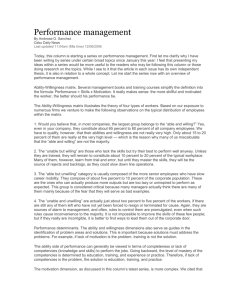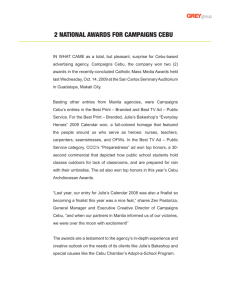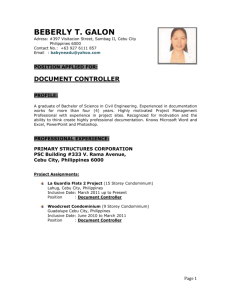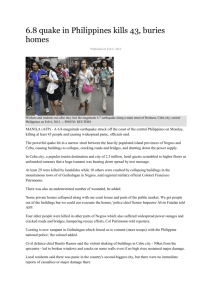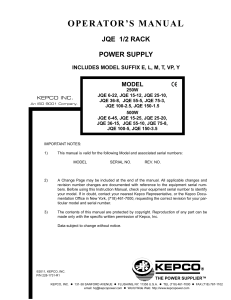case analysis outline
advertisement
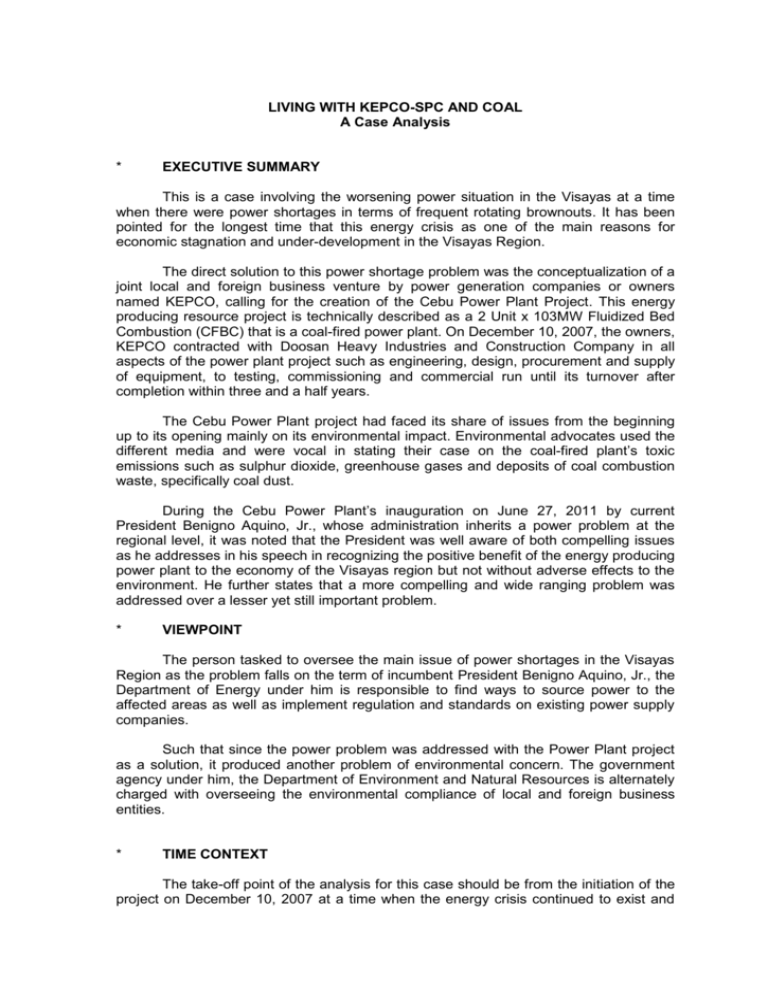
LIVING WITH KEPCO-SPC AND COAL A Case Analysis * EXECUTIVE SUMMARY This is a case involving the worsening power situation in the Visayas at a time when there were power shortages in terms of frequent rotating brownouts. It has been pointed for the longest time that this energy crisis as one of the main reasons for economic stagnation and under-development in the Visayas Region. The direct solution to this power shortage problem was the conceptualization of a joint local and foreign business venture by power generation companies or owners named KEPCO, calling for the creation of the Cebu Power Plant Project. This energy producing resource project is technically described as a 2 Unit x 103MW Fluidized Bed Combustion (CFBC) that is a coal-fired power plant. On December 10, 2007, the owners, KEPCO contracted with Doosan Heavy Industries and Construction Company in all aspects of the power plant project such as engineering, design, procurement and supply of equipment, to testing, commissioning and commercial run until its turnover after completion within three and a half years. The Cebu Power Plant project had faced its share of issues from the beginning up to its opening mainly on its environmental impact. Environmental advocates used the different media and were vocal in stating their case on the coal-fired plant’s toxic emissions such as sulphur dioxide, greenhouse gases and deposits of coal combustion waste, specifically coal dust. During the Cebu Power Plant’s inauguration on June 27, 2011 by current President Benigno Aquino, Jr., whose administration inherits a power problem at the regional level, it was noted that the President was well aware of both compelling issues as he addresses in his speech in recognizing the positive benefit of the energy producing power plant to the economy of the Visayas region but not without adverse effects to the environment. He further states that a more compelling and wide ranging problem was addressed over a lesser yet still important problem. * VIEWPOINT The person tasked to oversee the main issue of power shortages in the Visayas Region as the problem falls on the term of incumbent President Benigno Aquino, Jr., the Department of Energy under him is responsible to find ways to source power to the affected areas as well as implement regulation and standards on existing power supply companies. Such that since the power problem was addressed with the Power Plant project as a solution, it produced another problem of environmental concern. The government agency under him, the Department of Environment and Natural Resources is alternately charged with overseeing the environmental compliance of local and foreign business entities. * TIME CONTEXT The take-off point of the analysis for this case should be from the initiation of the project on December 10, 2007 at a time when the energy crisis continued to exist and there were also perceived environmental concerns, until its inauguration for commercial operation on June 27, 2011, which at that point was the completion of the Cebu power plant project as a remedy to the power shortage. I. PROBLEM STATEMENT The problem is that the Cebu coal-fired plant being a needed solution to the continuing power shortages but is given as the cause for environmental and health concerns brought about by coal wastes affecting in some localities of Cebu province. These concerns are highlighted by environmental activists and magnified disproportionately by media to raise issue and attention calling for inclusion of proper toxic waste management solution as priority agenda for government officials. II. STATEMENT OF THE OBJECTIVE To sustain continued power generation of the Cebu coal-fired power plant with the immediate prioritization on reduction moving towards effective elimination of toxic wastes such as coal dust to acceptable levels by soliciting advanced methods of proper toxic waste management and controls. III. AREAS OF CONSIDERATION Strengths. On President Aquino’s inaugural statement of the Cebu power plant, gave notice to an environmental concern and shows that a problem as such, may be resolved thru concerted efforts by local and national sides. President Aquino showed the way on how to face problems squarely and to follow through even on issues of concern. Weaknesses. The difficulty as to who will be charged to address the environmental concern, being that KEMPCO owns the Cebu power plant should be forced to comply with environmental standards. Considering political concerns, to some, addressing the environmental issue may not be worthwhile as the power plant is perceive more positively for its benefits outweighing the environmental concerns. Opportunities. The local governments thru enactment of laws and political will should be able to address the environmental problem thru enforcing proper coal waste disposal measures. Threats. Using the environmental issue by the local officials of Cebu province to their political purposes will hinder cooperation in the formulation and implementation of environmental laws. ASSUMPTIONS It is assumed that having an environmental issue, politicians will be expected to act either to neglect the problem as of small importance or using the issues to enhance their political image. A political opposition will use the environmental issue to criticize the incumbent leadership, the main purpose being the next election. V. ALTERNATIVE COURSES OF ACTION (ACA) ACA1. With the continued operation of the Cebu power plant, KEPCO being the owners should be afforded the opportunity to gradually implement proper waste management programs. It is the responsibility of the company owners to address the issue at the soonest but with consideration of the fact that KEPCO, in the beginning of commercial operations of the power plant have yet to realize profit, and funding for immediate unprogrammed maintenance operation such as comprehensive waste management is difficult. As such, KEMPCO owners should be reminded constantly of the environmental damage of coal wastes for them to prioritize effective waste management program at the soonest. ACA2. Immediate enforcement of existing environmental laws. National and local environmental agencies can file civil cases or penalize the company if proven to wilfully failed to address health concerns and environmental damage. Financial penalties will force the power plant owners set their attention to prioritizing effective waste management programs. ACA3. Local government legislation in enactment of stronger environmental laws. This may be the case when existing laws are outdated or the imposable penalties do not pose a deterrent for environmental pollution and human health endangerment violations. ACA4. Closing down of the power plant facility until KEPCO investors meet environmental obligations if proven that there is profound and irreversible threat to human life and quality of living conditions. VI. ANALYSIS Each ACA should be discussed in the light of the Areas of Consideration and Assumptions. Advantages and disadvantages of each ACA should be identified by way of considering the SWOT. ACA1. With the continued operation of the Cebu power plant, KEPCO being the owners should be afforded the opportunity to gradually implement proper waste management programs. Advantages- Aside from the continued operation of the power plant. The owners will be given the opportunity to address the problem at their own expense and initiative. KEPCO has the moral obligation to make sure their business operation are not damaging to life and environment. Disadvantages – relying on the company to install more expensive waste management technology issue may take a longer time. ACA2. Immediate enforcement of existing environmental laws. National and local environmental agencies can file civil Advantages – This course of action takes initiative from DENR, the national agency for the enforcement of environmental laws. This will also attract media attention to put the company in bad light which may prompt them to address the problem cases or penalize the company if proven to wilfully failed to address health concerns and environmental damage. Disadvantages If the environmental laws to be implemented are not too harsh. The company may opt to just pay the penalties if they can afford to do so. This delays the purchase of more expensive waste management technology. ACA3. Local government legislation in enactment of stronger environmental laws. Advantages – The national and local legislators will play a more active role in pursuing the enactment of stronger environmental laws with stiffer penalties. Disadvantages – This may take long time, if environmental issues are not in the priority agenda of legislators. ACA4. Closing down of the power plant facility until KEPCO investors meet environmental obligations if proven that there is profound and irreversible threat to human life and quality of living conditions. VII. Advantages – this can give immediate resolution to the coal waste pollution problem. Disadvantages – This will further prolong the power shortage crisis. RECOMMENDATION The first Alternative Course of Action (ACA1) calls for giving KEPCO, the opportunity to follow through in the operational cleanup of the toxic mess produced by the Cebu Power Plant. This proposes that some leeway be given to the company that does not set deadline or time frame as to how soon they should be able to completely contain the coal dust, but it does not absolve them from the issue rather no strict compliance is asked from the company. This ACA is a passive measure that is not costly in financial terms of implementation, it is easy to implement by sending a memorandum or letter of compliance to KEPCO, and can be done immediately. The only drawback for this ACA is the results which will depend on the response of the company, and may take while before any action will be made. The second Alternative Course of Action (ACA2) takes a more active approach by which the problem is dealt responsibly by government agencies such as the DENR in taking initiative to demand KEPCO for strict compliance to existing environment laws. This ACA can is not costly because government resources are used such as lawyers, environmental investigators will be commissioned or the cases may be filed against KEPCO as it can turn into a legal battle. It can be somewhat easy to implement because apart from legalities, there will also be political and media pressure that will expose the failings of the Cebu Power Plant. Political and media factors will figure in this ACA and results to action are dependent on strategic implementation of this ACA. The third proposed Alternative Course of Action(ACA3) is a remedial measure to correct existing weak environmental laws. In the national level, Congress can amend to strengthen Clean Air Act of 1999. On the local level, the Cebu local council can enact a provisional ordinance for the purpose of working out the implementation of stricter standards of environmental compliance with stiffer penalties. This ACA is dependent on political will, whether enacting environmental laws will be made priority of legislators. The merit of this ACA lies on the fact that if penalties imposed by existing laws are affordable for law violators, then the laws must be revised with more stricter and expensive penalties so as to provide a deterrent and warning from violating the law once more. The fourth Alternative Course of Action (ACA4) is a drastic measure, which may be counter productive to the cause of energy crisis. Shutting down the power plant until the damage to environment has been addressed sends a clear message that the government is more serious on environmental issues. There is a process to this action, as it has to be proven first that there is irreparable damages and threat to human life. Comparative analysis of each ACA should be made by way of identifying the variables and how each variable is rated for each ACA. Comparison is summarized by a DECISION MATRIX, which will now show the ACA to be adopted DECISION MATRIX (Multiple Criteria Decision Analysis) 4-Best 3-Very Good 2- Better 1-Low Cost Easy to Immediate Implement Results ACA1 4 3 2 ACA2 4 3 3 ACA3 2 3 1 ACA4 1 4 4 Time spent Total 4 4 1 3 13 14 7 12 . VIII. PLAN OF ACTION Based on extensive analysis of different alternative courses of action, it is recommended that the plan of action to be executed will be ACA2 or the enforcement of existing national and local environmental laws. In following this course of action initially, the DENR which at the beginning of the Cebu power plant project had given the environmental clearance for the project to push through in 2007. It is therefore it is necessary for DENR to conduct some investigation as to whether KEPCO, wilfully neglected its obligation in protecting the community from harmful toxic wastes. Based on reports, KEPCO made change orders to increasing the size of the holding area and this containment minimized the leakages. But this is not enough, if there are still leakages the DENR should then impose penalties as provided by law. In the Philippines, there are enough laws and the key will be successful implementation and enforcement of existing environmental laws. The government of the Philippines should take the lead in protecting the habitat and lives of its people as well as protecting the environment for future generations.

